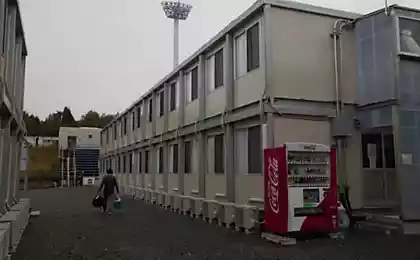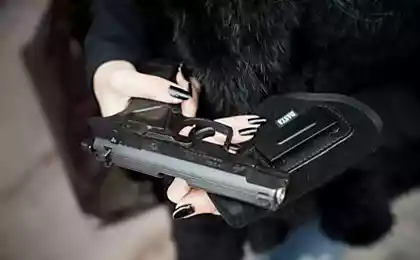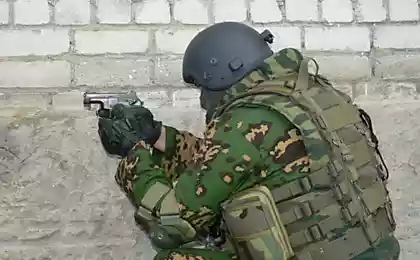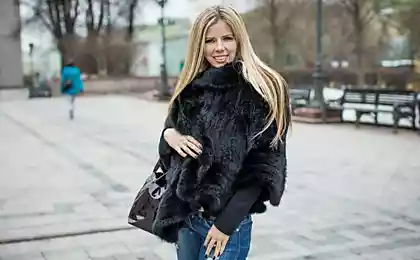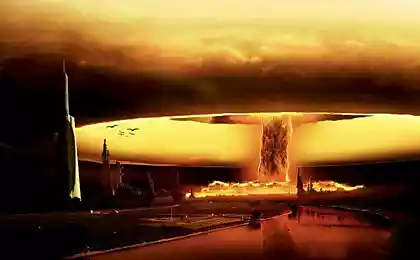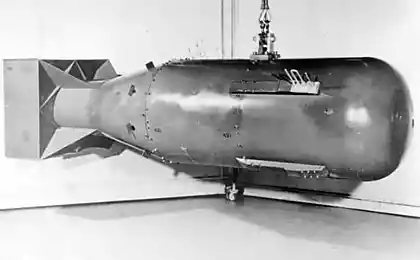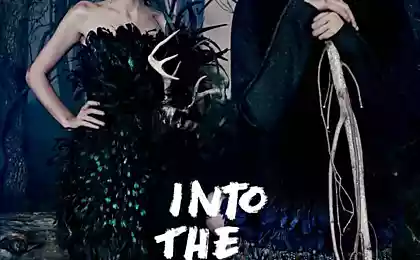1220
Japan. Weapons past.
A brief excursion into the past. A selection of 23 photos. If something is not taken into account, please offer your options. I offered some of the most interest to me.
Japanese bow (Yumi) has a length of 180 to 250 cm. It should be borne in mind that, unlike the English or the Mongolian asymmetrical Japanese bow, and its lower end two times shorter than the upper. This type of onion is also found among the Evenki. The bowstring is pulled him not to ear, as in English onion, and behind the ear, back, and boom length can vary from 11 to 15 hands. Shooting of it was conducted from both standing and kneeling, or galloping.
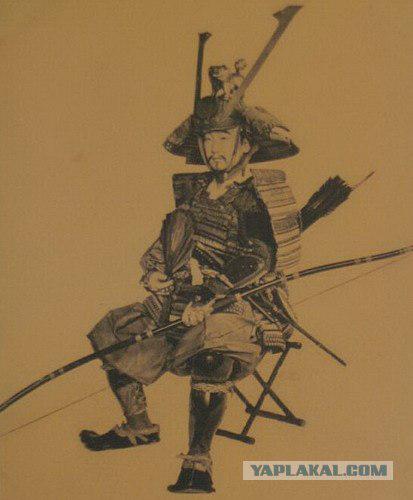
Tabiyumi - edged weapon, Japanese folding camp onions, bamboo consists of two halves held together by a metal hinge with a lock. Boom for tabiyumi tabiyya are called, they are often hidden in the frame Japanese straw hat "touch" and are equipped with poisoned tips.
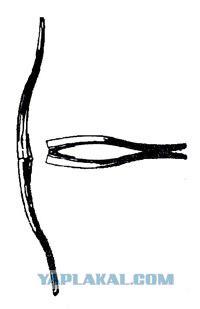
Jari - generic name for various kinds of Japanese spears.
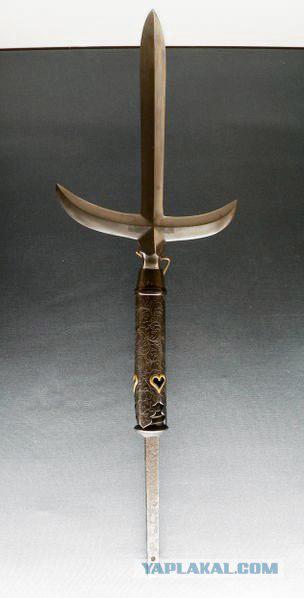
Jari variety
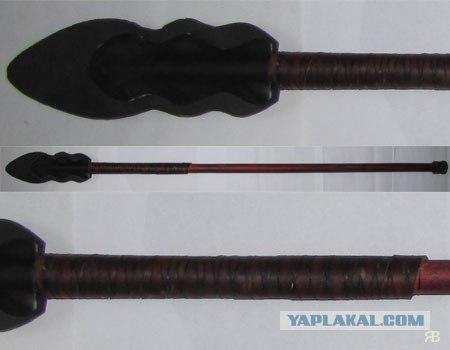
Tati - long Japanese sword. Tati, unlike the katana, Do not insert for obi (waist cloth) blade up, and suspended on the belt provided for this purpose in a sling blade down. To protect against damage to the sheath of armor were often winding. Samurai katana worn as part of the civil clothes, and thieves - as part of a military armor. Paired with Tachi Tanto were more common than referring to the katana wakizashi short sword. In addition, ornate thieves were used as ceremonial weapons in the courts of the shoguns (princes) and the Emperor. It is usually longer and more curved than the Katana (the majority of the length of the blade over 2, 5 shaku, ie more than 75 cm tsuka (handle) was also often longer and more curved).
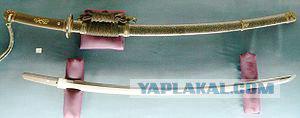
CODATA - literally translated as "small thieves", the sword tachi shorter than usual.
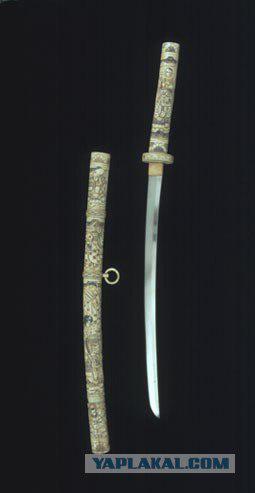
Wakizashi - short traditional Japanese sword. Mainly used by samurai and worn on a belt. It was worn in a pair with a katana, and plugging the belt edge up. Blade length - from 30 to 61 cm. The total length of 50-80 cm with a handle. Blade-sided sharpening, small curvature. Wakizashi is similar in shape to the katana. Vakidzasi zukuri made with different shapes and lengths, usually thinner than the katana. The degree of convexity section blade wakizashi much less so compared with a katana sword that cut soft objects more sharply. Handle vakidzasi usually square.
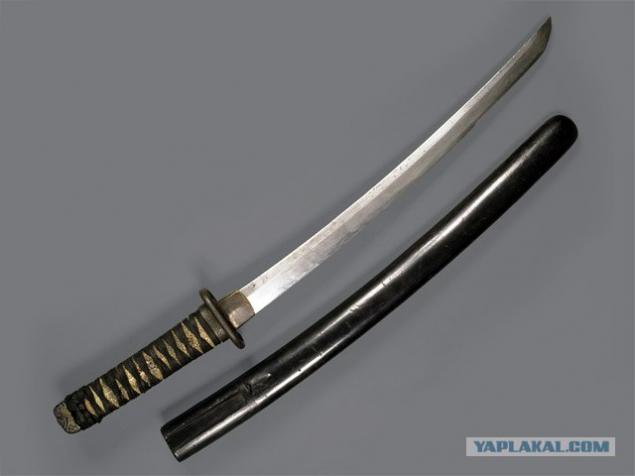
Tanto - samurai dagger. Tanto was only used as a weapon and never as a knife, for it existed Kozuka worn in a couple of bonus in one sheath. Tanto has a one-sided, sometimes a double-edged blade length of 15 to 30 cm 3 (ie, less than one shaku).

Odat (great sword) - a type of long Japanese swords. The term nodati ("field sword") is another type of sword, is often mistakenly used instead Odat. Odat to be called, had to have a sword blade length not less than 3 shaku (90, 9 cm), however, as in the case of many other Japanese terms related to swords, accurate determination of the length of Odat not. Usually Odat - is swords with blades 1, 6 - 1, 8 meters.
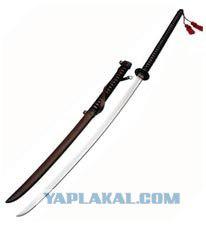
Naginata (long sword) - Japan edged weapons with a long-handled oval (that handle instead of the shaft as it may seem at first glance), and one-sided curved blade. Handle length of about 2 meters and a blade about 30 cm. In the course of history has become much more common shorter (1, 2-1, 5 m) and a lightweight version that was used in training and showed great fighting ability. Glaive is an analog (although it is often mistakenly referred to as a halberd), but much lighter.
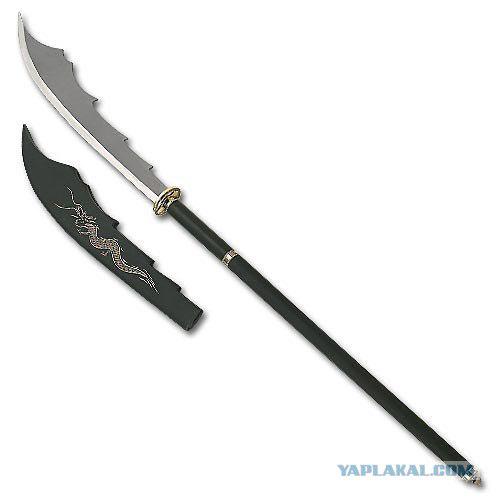
In peacetime, the naginata was used by women of the samurai class to protect their homes.
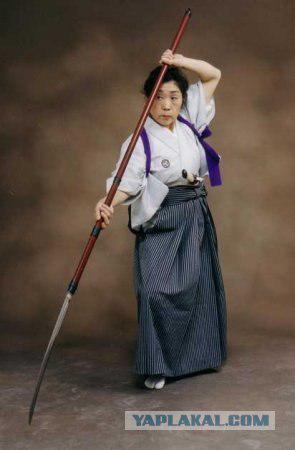
Katana - Japanese long sword. In modern Japanese katana and the word refers to any sword. The word "kata" means "sword with a curved blade one-sided." The shape resembles a katana sword, but he did not handle bent in the opposite side of the blade, as in the classic saber. The most significant difference from the katana sword is the art of its use: it can be both one-handed and two-handed capture (with a predominance of the latter), while the standard sword with one hand, and therefore requires the use of different fighting techniques.

Sai - stiletto in a metal trident. Sometimes masters were once 3 sai, one of which served as a ranged weapon and the other 2 were used for fencing.
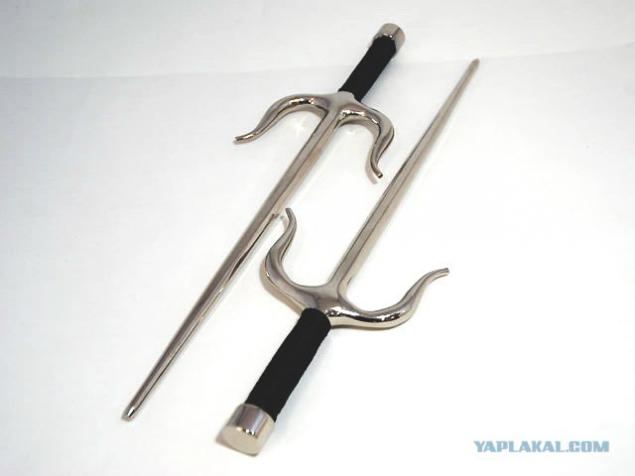
Kusari-gama or Kusari-kama - Japanese multicompound weapons, including sickle (kama), and long chain (kusari) with a weight at the end. Is this weapon around the end of the XV century from the simple kama sickle that was previously used in agricultural work. With the addition of the chain, Kusari-Gama became a separate type of weapon. Due to the fact that these weapons were combined, many soldiers thought he was dishonest use.
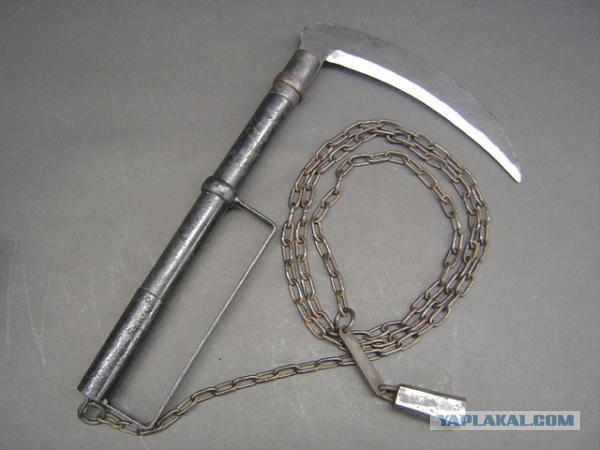
Shuriken - ("blade hidden in the hand") - Japanese throwing weapon concealed carry (although sometimes used for shock). Represents a small blade made according to the type of everyday things: stars, needles, nails, knives, coins and so on.

Bo shuriken - throwing weapon in the form of a wedge made of iron or steel; It has a quadrangular, circular or octagonal shape. Typically, sharpened on one side, but also occurs dvuostrye instances. The length of the bo shuriken ranges from 12 to 21 cm, and weighs from 35 to 150, the Weapons strikes in different ways: because of the head, bottom, side, and back, and in each of the variants of the blade with your fingers guided in the right direction. Not to be confused bo shuriken and kunai (impact bonder and weapons, which is also sometimes used as a missile). Bo means "needle"; photo - no needles, and preparation for a Kunai.
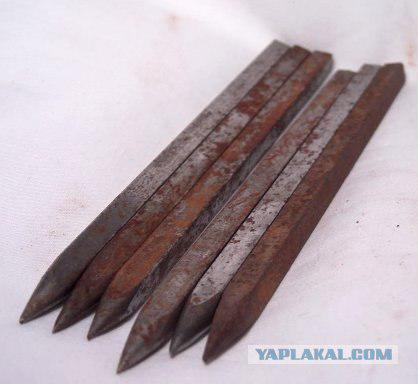
Hira shuriken made of thin metal plates made from ordinary objects: from coins (KHISI gan), carpentry tools (Kuga-Nuki) and others. Because of their shape often referred to as "sprockets ninja". In the center of Hira shuriken is a hole that allows you to transfer them to the rope and gives a flight aerodynamic effect. There are many types of shuriken, and they are often distinguished by the number of pointy tips. Just as in the case of bo shuriken, Hira shuriken various forms associated with the schools in which they are used.
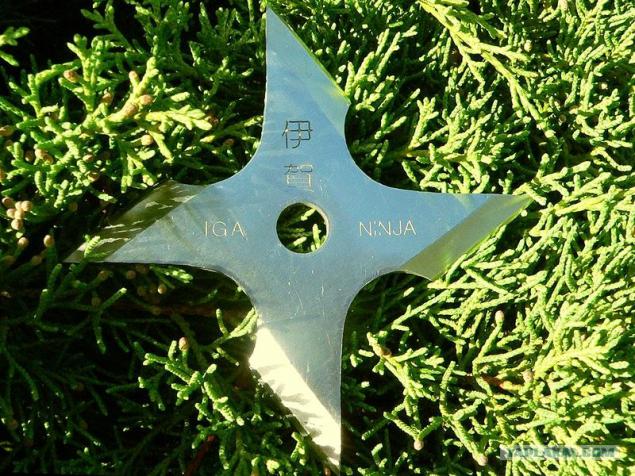
Jitte - Japan edged weapons used ninja and some units of the Japanese police in the Edo period. In our time it is used in the Japanese martial art of Jitte-jitsu.
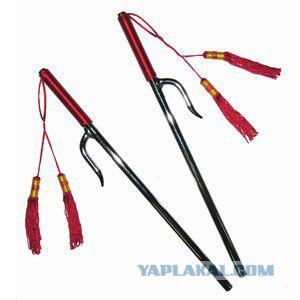
Upper cross capture
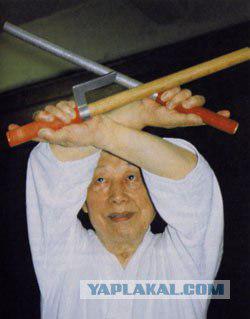
Takkokagi (uchi LASS) - melee weapon used ninja inflicted terrible injuries on the body and leaves victims open wounds and scars. Such weapons are often used to achieve a psychological superiority over the enemy. When ninjas jump out of the darkness, or to jump from tree one kind of weapon it was enough to draw the enemy to flight.
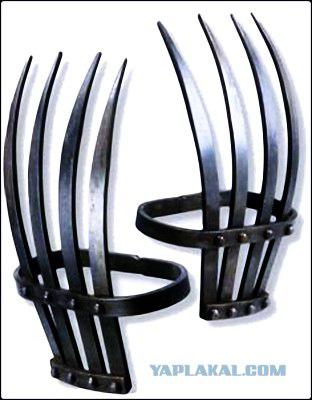
Nekote (cat foot)
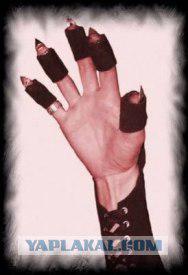
Manrique-Kusari - complex percussion edged weapon, a kind torinava (consists of a rope with weights having a different shape and weight, fastening on one or both ends of the rope in the same weights is at the opposite end of the braid, which serves as a handle), but replaced with a chain length which is 1000 mm, the total weight of 500g. Weights vary from weapon form that allows us to give the name of his subspecies: Kusari-kama, Kusari-Fundo etc.
FSE, a format not climbed
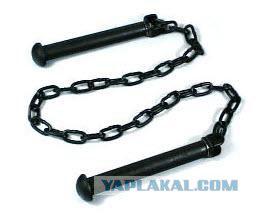
Source:
Japanese bow (Yumi) has a length of 180 to 250 cm. It should be borne in mind that, unlike the English or the Mongolian asymmetrical Japanese bow, and its lower end two times shorter than the upper. This type of onion is also found among the Evenki. The bowstring is pulled him not to ear, as in English onion, and behind the ear, back, and boom length can vary from 11 to 15 hands. Shooting of it was conducted from both standing and kneeling, or galloping.

Tabiyumi - edged weapon, Japanese folding camp onions, bamboo consists of two halves held together by a metal hinge with a lock. Boom for tabiyumi tabiyya are called, they are often hidden in the frame Japanese straw hat "touch" and are equipped with poisoned tips.

Jari - generic name for various kinds of Japanese spears.

Jari variety

Tati - long Japanese sword. Tati, unlike the katana, Do not insert for obi (waist cloth) blade up, and suspended on the belt provided for this purpose in a sling blade down. To protect against damage to the sheath of armor were often winding. Samurai katana worn as part of the civil clothes, and thieves - as part of a military armor. Paired with Tachi Tanto were more common than referring to the katana wakizashi short sword. In addition, ornate thieves were used as ceremonial weapons in the courts of the shoguns (princes) and the Emperor. It is usually longer and more curved than the Katana (the majority of the length of the blade over 2, 5 shaku, ie more than 75 cm tsuka (handle) was also often longer and more curved).

CODATA - literally translated as "small thieves", the sword tachi shorter than usual.

Wakizashi - short traditional Japanese sword. Mainly used by samurai and worn on a belt. It was worn in a pair with a katana, and plugging the belt edge up. Blade length - from 30 to 61 cm. The total length of 50-80 cm with a handle. Blade-sided sharpening, small curvature. Wakizashi is similar in shape to the katana. Vakidzasi zukuri made with different shapes and lengths, usually thinner than the katana. The degree of convexity section blade wakizashi much less so compared with a katana sword that cut soft objects more sharply. Handle vakidzasi usually square.

Tanto - samurai dagger. Tanto was only used as a weapon and never as a knife, for it existed Kozuka worn in a couple of bonus in one sheath. Tanto has a one-sided, sometimes a double-edged blade length of 15 to 30 cm 3 (ie, less than one shaku).

Odat (great sword) - a type of long Japanese swords. The term nodati ("field sword") is another type of sword, is often mistakenly used instead Odat. Odat to be called, had to have a sword blade length not less than 3 shaku (90, 9 cm), however, as in the case of many other Japanese terms related to swords, accurate determination of the length of Odat not. Usually Odat - is swords with blades 1, 6 - 1, 8 meters.

Naginata (long sword) - Japan edged weapons with a long-handled oval (that handle instead of the shaft as it may seem at first glance), and one-sided curved blade. Handle length of about 2 meters and a blade about 30 cm. In the course of history has become much more common shorter (1, 2-1, 5 m) and a lightweight version that was used in training and showed great fighting ability. Glaive is an analog (although it is often mistakenly referred to as a halberd), but much lighter.

In peacetime, the naginata was used by women of the samurai class to protect their homes.

Katana - Japanese long sword. In modern Japanese katana and the word refers to any sword. The word "kata" means "sword with a curved blade one-sided." The shape resembles a katana sword, but he did not handle bent in the opposite side of the blade, as in the classic saber. The most significant difference from the katana sword is the art of its use: it can be both one-handed and two-handed capture (with a predominance of the latter), while the standard sword with one hand, and therefore requires the use of different fighting techniques.

Sai - stiletto in a metal trident. Sometimes masters were once 3 sai, one of which served as a ranged weapon and the other 2 were used for fencing.

Kusari-gama or Kusari-kama - Japanese multicompound weapons, including sickle (kama), and long chain (kusari) with a weight at the end. Is this weapon around the end of the XV century from the simple kama sickle that was previously used in agricultural work. With the addition of the chain, Kusari-Gama became a separate type of weapon. Due to the fact that these weapons were combined, many soldiers thought he was dishonest use.

Shuriken - ("blade hidden in the hand") - Japanese throwing weapon concealed carry (although sometimes used for shock). Represents a small blade made according to the type of everyday things: stars, needles, nails, knives, coins and so on.

Bo shuriken - throwing weapon in the form of a wedge made of iron or steel; It has a quadrangular, circular or octagonal shape. Typically, sharpened on one side, but also occurs dvuostrye instances. The length of the bo shuriken ranges from 12 to 21 cm, and weighs from 35 to 150, the Weapons strikes in different ways: because of the head, bottom, side, and back, and in each of the variants of the blade with your fingers guided in the right direction. Not to be confused bo shuriken and kunai (impact bonder and weapons, which is also sometimes used as a missile). Bo means "needle"; photo - no needles, and preparation for a Kunai.

Hira shuriken made of thin metal plates made from ordinary objects: from coins (KHISI gan), carpentry tools (Kuga-Nuki) and others. Because of their shape often referred to as "sprockets ninja". In the center of Hira shuriken is a hole that allows you to transfer them to the rope and gives a flight aerodynamic effect. There are many types of shuriken, and they are often distinguished by the number of pointy tips. Just as in the case of bo shuriken, Hira shuriken various forms associated with the schools in which they are used.

Jitte - Japan edged weapons used ninja and some units of the Japanese police in the Edo period. In our time it is used in the Japanese martial art of Jitte-jitsu.

Upper cross capture

Takkokagi (uchi LASS) - melee weapon used ninja inflicted terrible injuries on the body and leaves victims open wounds and scars. Such weapons are often used to achieve a psychological superiority over the enemy. When ninjas jump out of the darkness, or to jump from tree one kind of weapon it was enough to draw the enemy to flight.

Nekote (cat foot)

Manrique-Kusari - complex percussion edged weapon, a kind torinava (consists of a rope with weights having a different shape and weight, fastening on one or both ends of the rope in the same weights is at the opposite end of the braid, which serves as a handle), but replaced with a chain length which is 1000 mm, the total weight of 500g. Weights vary from weapon form that allows us to give the name of his subspecies: Kusari-kama, Kusari-Fundo etc.
FSE, a format not climbed

Source:


